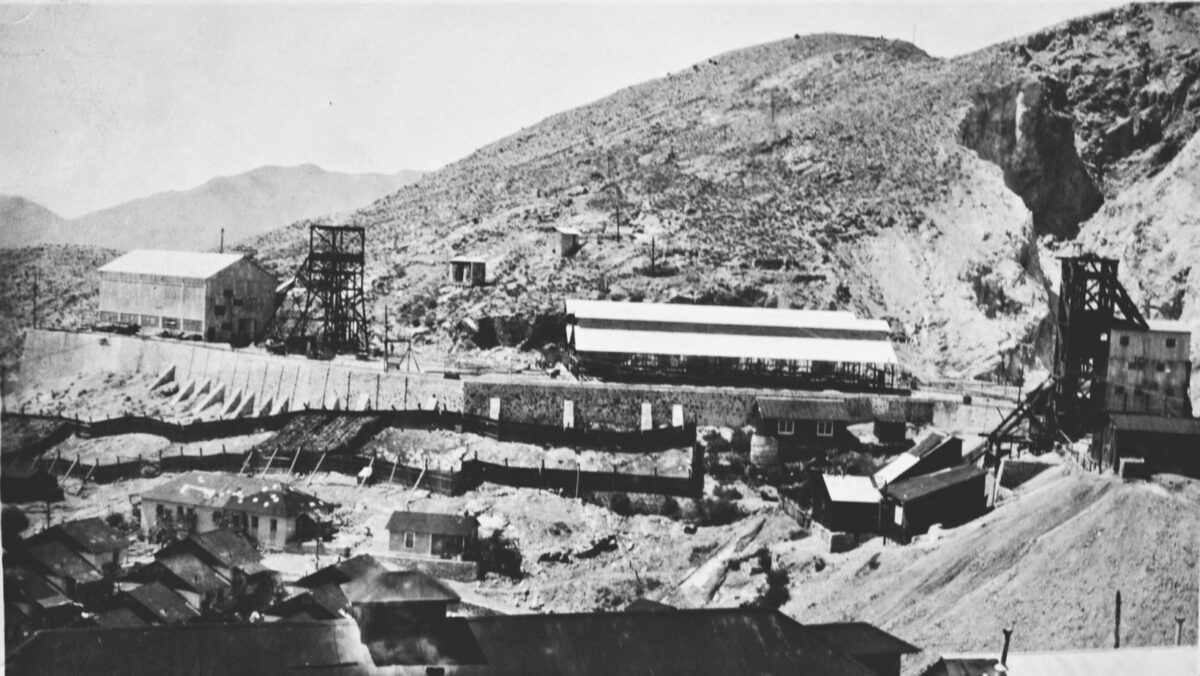
The Pilares Mine in 1910: A Historical Perspective
7 de marzo de 2025
By L. J. Deltworth
“It is the second largest ore body in the world”
(1910) – The Pilares mine, located about 6 miles from Nacozari, under the management of J. S. Williams, Jr., is one of the principal holdings of the Moctezuma Copper Co. They are operating as usual and J .S. Williams, time keeper for the mines, has a record in his office showing 27,500 tons of ore were taken out during the month of June. The concentrator is not operating to its full capacity, owing to a shortage in the water supply, which, however, will not affect the mine’s operations to any great extent, as the rains which have been very slow in coming this year, have now begun. The high grade ore, of which there are great quantities, is taken directly to the company’s Copper Queen smelter at Douglas and the low grade ore is taken to the concentrator, thereby lessening the cost of shipment very materially.
There are two shafts or sections of the mine; one called the Pilares and the other the Esperanza. Both are being operated by the tunnel system, through which the mine is drained, keeping all the levels dry. They use electric motors in those tunnels, which haul long strings of ore cars which are filled through chutes from the stopes. This mine is operated by contract very cheaply, and in a most scientific manner, with the greatest safety; mining practically without timbers. The ore body is so solid and firm that there is no more danger of its caving in than there is of a worm-hole in an apple.
The 500 level, J. W. Barker, foreman, is one of the very large producers. The work is all done on the extend-fill system, filling up within 6 feet of the back. They take about 4 ft. of ore, making about 11 or 12 feet out after it is finished. The fills are run through raises. Everything in the stopes is done with machinery, using Waugh and Shaw machines. They also use the Sullivan piston drills. The work is progressing very nicely on all the levels. The 300, John Grutza, foreman, is an especially good level, as it is the driest in the mine; and here is found some very high grade ore. The highest grade, however, is found on the 200 level.
The Esperanza side is connected with the Pilares by tunnel. In this mine there are at least 200 miles of work. It is the second largest ore body in the world, there being one in Spain (the Rio Tinto) that is supposed to be a little larger. There is enough ore in sight to keep them operating constantly for 50 years. C. I. Stralia, superintendent of the Esperanza side of the mine, states that it is the general opinion that this ore body, which has the shape of a pear and essentially no outlet, was once a volcano. Tunneling through the caliche wall at various places they have found great quantities of very rich ore. F. M. Spalding, chief clerk at the mine office, states that an experienced mining engineer stated to him that the caliche was the “seed of the ore,” while most engineers considered it useless to go beyond the caliche walls. Yet by doing so they found that, in this instance at least, his theory was correct.
Superintendent J. S. Williams, Jr., states that they are soon to install a 2500 cu. ft. air compressor; and that now they are extending the Esperanza shaft adding two more bays to it.
The Store
At Nacozari proper they have one of the best equipped stores in Northern Mexico, and under the able management of C. H. Melcher, assisted by W. A. Meyers, things are running smoothly. This is an up-to-date-department store. In the dry goods department, they have a stock of goods well selected to supply the demands of all classes. The supply department where is handled a line of the best supplies; when walk into the grocery department you might as well think you were in the states, for you will not best American goods as well as Mexican products. Here you can purchase anything and everything to make the palate glad, and they are sold as reasonable as one could expect, considering the high duty on American goods. The Mexican products, of course, are much cheaper, and in many instances very good: but one naturally clings to what they have been used to; consequently, there is a very large demand for American products.
The Ice Plant
The Nacozari ice plant of a capacity of 10 tons per day is certainly a boon and also something of a rarity in this section of country. They furnish the Pilares mine with ice, as well as the town, and furnish ice as cheaply as you can get it at home. In fact, everything about Nacozari is so modern and homelike one would hardly recognize the fact that he was in a foreign land.
The Power Plant
There is also a large power plant here, which is equipped with every modern appliance. Turbine engines, 3 of the boilers being equipped with automatic stokers, and the fourth is now under construction. These automatic stokers are the means of great saving in fuel as well as labor.
The Hospital
You will find here a hospital that would be a credit to a much larger place. It is a large sanitary building, surrounded by grounds that abound in sweet-scented flowers and trees; and they do say that some of the patients are very loth to leave when they are well, so pleasant are the surroundings. It is equipped in a most up-to-date manner. The company taxes each man a dollar on thereabouts a month, this giving them the privilege of medical attention from the physician in charge, with all drugs furnished; and of the latter they are supplied with everything that is needed, and prepared to compound everything from the simplest pellet to the most scientific prescription, the physician being one of the best in the Republic. They handled 2,500 patients during last month. Of course, a great many of these cases were slight ailments and accidents.
A great many of the poorer class of Mexicans are affected with tuberculosis of the skin, a very loathsome disease, caused mostly by uncleanliness. There are three wards, separate wards for the men, for the women and a separate American ward. This hospital was built principally to take care of the men who receive injuries in the mine, but they handle any and all classes of illness as well. Also, take outside paying patients on application. They have what they term the accident room, which is kept in readiness for any accident, no matter how severe, with bandages, instruments, drugs: everything in place for emergencies of all kinds, where patients can be attended to and cared for with the greatest haste and efficiency.
Adjoining the operating room, they have a great number of what they term “window patients.” The physician stands at a small window from 7 a.m. to 7 p.m., handing out medicine to patients with small and sometimes imaginary ailments; also furnishing them the staple drugs, such as turpentine, glycerin, quinine, pills, etc.
In the kitchen they have the best of cooks and from their own garden back of the hospital, attended by the Jap boy servant, they can soon tempt them back to life and health, and the old proverb, “Cleanliness is next to Godliness” must be the motto here, for everything is immaculate.
Published on Bisbee Daily Review
Bisbee, Arizona, August 7, 1910
Original Title: The Pilares Mine
© All Rights Reserved
